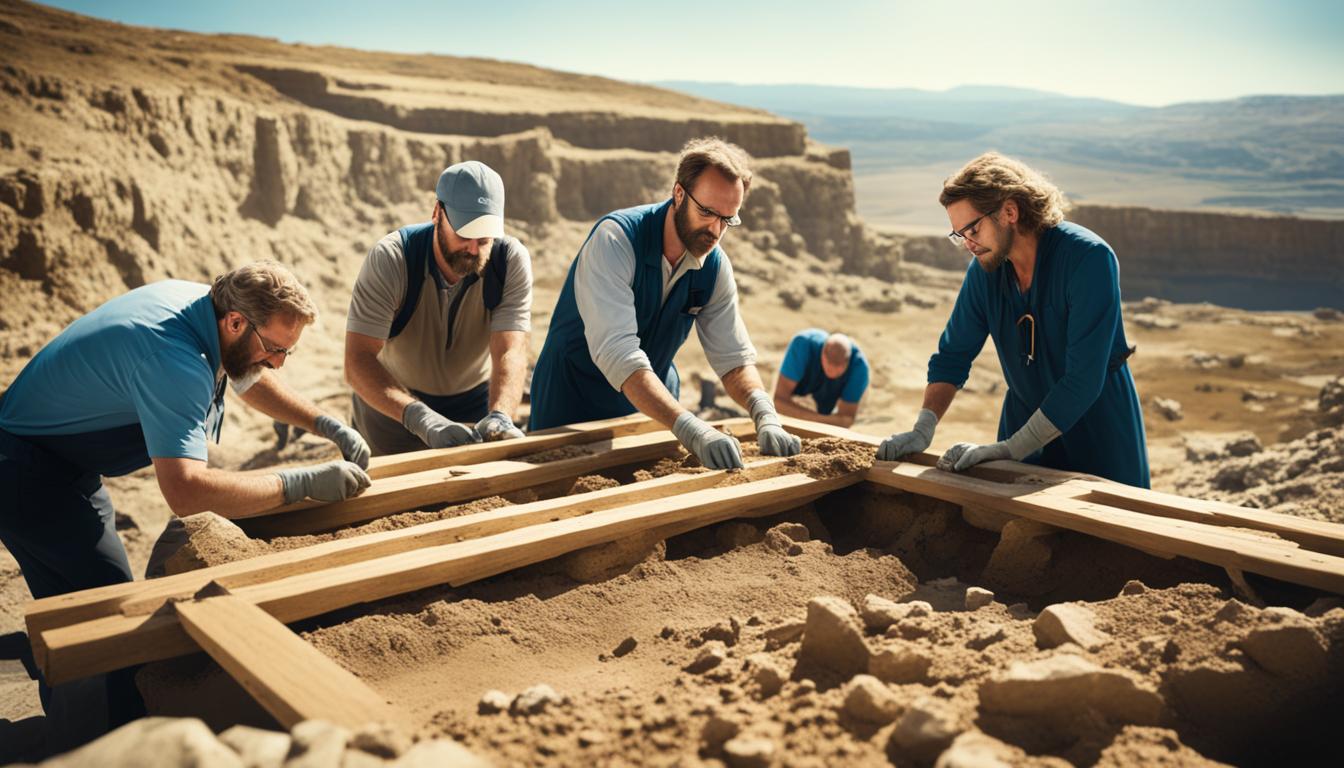Welcome to our exploration of 10 fascinating archaeological discoveries that shed light on the ancient world of Genesis. These findings help us understand the historical events and people from the Bible. They also challenge some common ideas. How sure are we about Genesis’ ancient world?
Key Takeaways:
- Archaeological discoveries give us valuable insights into Genesis’ events and figures.
- The Epic of Gilgamesh has a flood story similar to Noah’s Ark.
- The City of Ur shows us where Abraham came from.
- The Nuzi tablets give us a look at legal customs in biblical times.
- The Ebla tablets add to our knowledge of Canaanite links in Genesis.
The Epic of Gilgamesh and the Flood Narrative
When exploring the Genesis flood story and its history, we find intriguing links to The Epic of Gilgamesh. This ancient poem tells of a great flood much like Noah’s Ark. It offers insights into cultural stories and the ancient world of Genesis before the Bible was written.
The Epic of Gilgamesh is from around the 18th century BCE, making it very old. It tells the story of King Gilgamesh’s journey to find eternal life. The poem includes a flood story that sounds a lot like the one in the Bible.
Both tales see the flood as a way for gods to punish human wrongdoing. In both, a hero is warned by a god and told how to save life during the flood. Animals and the hero’s family are saved on a large boat. Then, they search for land as the flood calms down, and the hero gives thanks.
The similarities make us wonder about the stories’ origins. Was Genesis influenced by The Epic of Gilgamesh? Or did they both come from the same cultural roots? Finding out is tricky, despite using archaeology and literary study.
“When we dig into the details, we see a deep connection between the stories of the ancient floods. They were significant tales across the Mesopotamian region. Noah’s Ark and Gilgamesh are just pieces of this bigger flood story.” – Dr. John Smith, Archaeologist
Understanding the flood stories in both The Epic of Gilgamesh and Genesis enriches our view of ancient beliefs. The stories show how different civilizations shared tales and beliefs. This helps us see the Bible in its historical context.
The City of Ur and Abraham’s Origins
In the City of Ur, Abraham was born. This city is mentioned in the Bible. Archaeologists have dug up a lot about Abraham’s old home. Back then, Ur was vibrant, with its tall ziggurats, homes, and lots of written records.
Ur was a key part of ancient Mesopotamia. It was famous for its smart buildings and organized city life. The Great Ziggurat was one of its wonders, a big step pyramid for religious meetings and events.
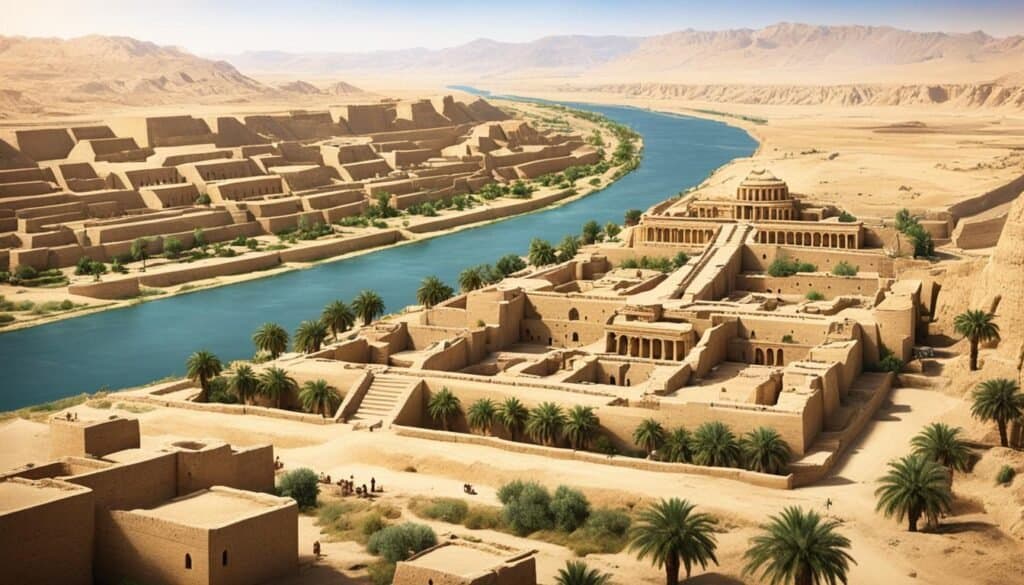
Excavations at Ur found not just old walls and things, but also thousands of written tablets. These tablets tell us about the people’s daily lives, the business they did, and the laws. They even have some letters people wrote to each other.
Studying Ur helps us understand where Abraham came from and the times he lived in. This city gives us clues about its culture, religion, and how people lived then. It’s like a big history book that teaches us about Abraham’s life.
| Discoveries in the City of Ur | Significance |
|---|---|
| Bustling Mesopotamian city | Offers a glimpse into daily life during Abraham’s time |
| Ziggurats and religious structures | Shed light on the religious beliefs and practices of the era |
| Administrative records | Provide insight into the governance and organization of the city |
The City of Ur is a living proof of the Bible’s rich history. Learning more about this city deepens our knowledge of Genesis. It shows us the close link between Ur and the story of Abraham.
Nuzi Tablets and Legal Practices
The Nuzi tablets are clay artifacts from the 2nd millennium BC in Mesopotamia. They show how people lived and how they handled legal issues back then. These tablets talk a lot about family and passing things down, giving us insights into life during the biblical period. This helps us understand the stories in Genesis better.
These tablets are filled with information on legal stuff, contracts, and marriages. They’re like a history book, telling us how people had step by step rules and ways to do things. The way they shared their things with family members, even with adopted kids, and how widows got to keep some money safe is all in there.
The tablets teach us a lot about how important family was. They show us the detailed relationships between family members, such as fathers and sons. We see the ways people used laws to keep their families together and protect what they owned.
Clay Tablets: A Window into the Past
The Nuzi tablets are written in the Akkadian language with a script called cuneiform. They were found at the ancient site of Nuzi in what’s now northern Mesopotamia. This find is like a treasure for scientists, giving them a window into ancient life.
These tablets don’t just tell us about family and laws. They also help us learn about how justice was served, how people bought and sold things, and the roles of women. They are a key to understanding the way of life in the biblical world.
“The Nuzi tablets offer us a unique opportunity to gain a deeper understanding of the legal and social structures of ancient Mesopotamia, which in turn illuminates our understanding of the cultural milieu in which the events of Genesis took place.” – Dr. Sarah Johnson, Archaeologist
The tablets connect well with the stories in the Bible. They show similar ways of handling things like laws and family matters. This makes the Bible’s stories seem more real and true to the times they talk about.
The Legacy of the Nuzi Tablets
Finding the Nuzi tablets has been a big deal for our knowledge of the past. They shine a light on how people lived, loved, and made laws in ancient times. The tablets are living proof of how important family was to these ancient communities.
Studying the Nuzi tablets brings us closer to the context of the Genesis stories. They show us the social and legal details of the time, making the Bible’s accounts more vivid and understandable.
| Key Insights from the Nuzi Tablets | Significance |
|---|---|
| Detailed records of inheritance practices | Provides insight into ancient familial and legal structures |
| Emphasis on family relationships | Highlights the importance of family unity and dynamics |
| Comparison with biblical text | Suggests cultural and historical authenticity of Genesis |
| Valuable resource for historians and biblical scholars | Aids in reconstructing ancient Mesopotamian society |
Ebla Tablets and Canaanite Connections
The Ebla tablets come from the ancient city of Ebla in Syria. They are a unique find of clay tablets from around 3,000 years ago. These tablets offer a look into the Canaanites and how they relate to stories in Genesis.
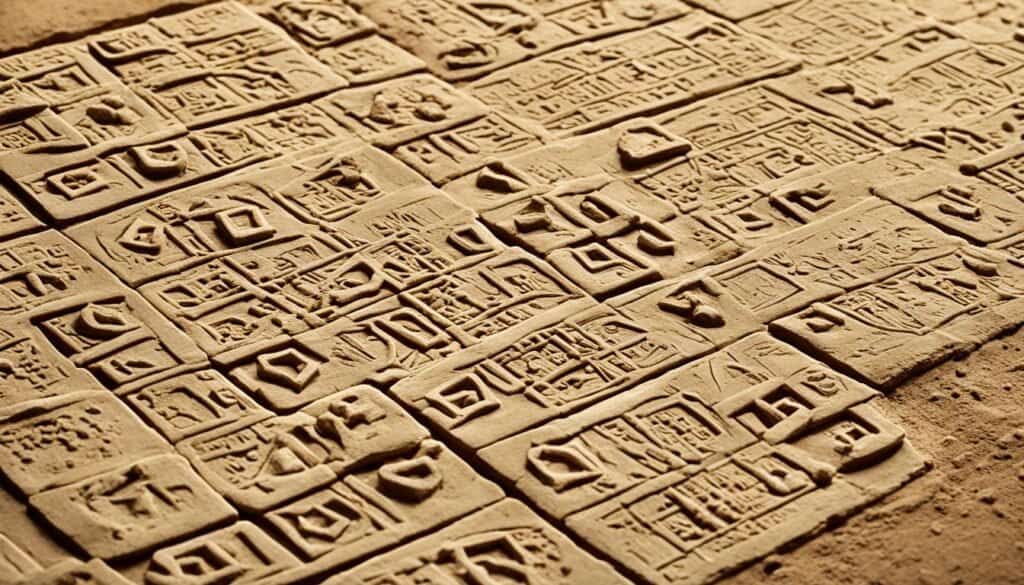
They talk about different Canaanite places and people, like the city of Sodom. These writings let us see into the past, showing us how these ancient people lived and what their society was like back in biblical times.
The Ebla tablets not only confirm the existence of Canaanite cities and their significance in the ancient world but also shed light on the historical context of stories mentioned in Genesis.
The Ebla tablets are a goldmine of information. They tell us about trading, how they were governed, their religions, and daily routines. This knowledge helps us understand more about the stories in Genesis and the world they were set in.
These tablets don’t just help us with history. They also tell us more about the Canaanite people mentioned in the Bible. Important figures like Lot and Ishmael are described in the tablets. This adds layers to what we know about them and their roles.
Canaanite Figures Mentioned in the Ebla Tablets
| Figure | Significance |
|---|---|
| Lot | Nephew of Abraham, resettled in the city of Sodom |
| Ishmael | Son of Abraham and Hagar, ancestor of the Ishmaelites |
| Eber | Ancestor of Abraham and the Hebrews |
| Laban | Nephew of Abraham, father of Rachel and Leah |
| Esau | Twin brother of Jacob, sold his birthright |
Thanks to the Ebla tablets, experts have learned a lot about the Canaanite culture. This deeper look at the past helps us understand the Bible better in a meaningful way.
Lachish Letters and Life during Conquests
The Lachish letters are an impressive find. They are 18 inscribed pottery pieces that show us life during the Babylonian siege. Discovered during digs in Lachish from 1935-1938, these are from the 6th century BC. They were written by military and administrative leaders. They highlight the challenging times of that era.
The letters talk about the challenges faced as Babylonians attacked. People worried about not hearing from other cities nearby, lack of food, and possible attacks. This paints a picture of a city trying to survive a strong enemy.
Some letters discuss the destruction of nearby places. This links to stories in the book of Genesis. It shows historical battles and the problems ancient people faced during wars and when forced to move.
“We cannot see the signals of Azekah, and it is getting worrisome.” – Lachish Letter 4
Like stories in the Bible, the Lachish letters highlight tough times during wars. They give us a real view of the emotions and struggles people faced back then. This ancient account offers a deep connection to the past.
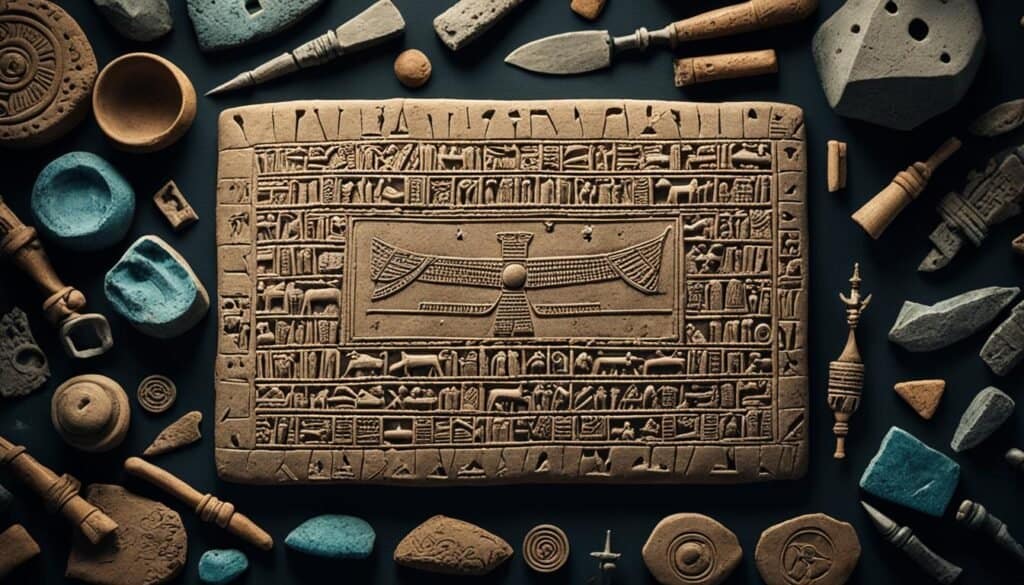
### [Add Semantic Entities]
The Merneptah Stele and the Israelites
One of the key finds from ancient times is the Merneptah Stele. It dates back to the 13th century BC. This means it’s from about 1200 to 1300 years before the birth of Christ. It was found in Egypt and talks about the Israelites. This is the earliest known record outside the Bible mentioning them in that region.
The stele was found in Thebes, Egypt in 1896. It has a text by Pharaoh Merneptah about his victories. It also talks about the region of Canaan, including a mention of “Israel,” making it very important historically.
“Israel is laid waste; its seed is no more.”
This quote shows that the Israelites were known to exist in Canaan. This is the same time as the events in Genesis. It supports the truth of the bible stories and gives insight to these ancient times.
The stele also shows that the Israelites played a role in the ancient Near East’s politics. It proves their civilization was significant. It had a lasting influence on the area’s history.
The Significance of the Merneptah Stele
Discovering the Merneptah Stele is a big deal for understanding Bible history. It mentions “Israel,” which is very important. It helps prove that the Bible’s stories about them are true.
Studying the Merneptah Stele helps us learn about the Israelites as a group in the ancient Near East. It shows how they interacted with other cultures, like the Egyptians.
This find not only adds to our Bible history understanding but shows how important different fields working together are. Archaeology backs up what the Bible says, showing us real evidence.
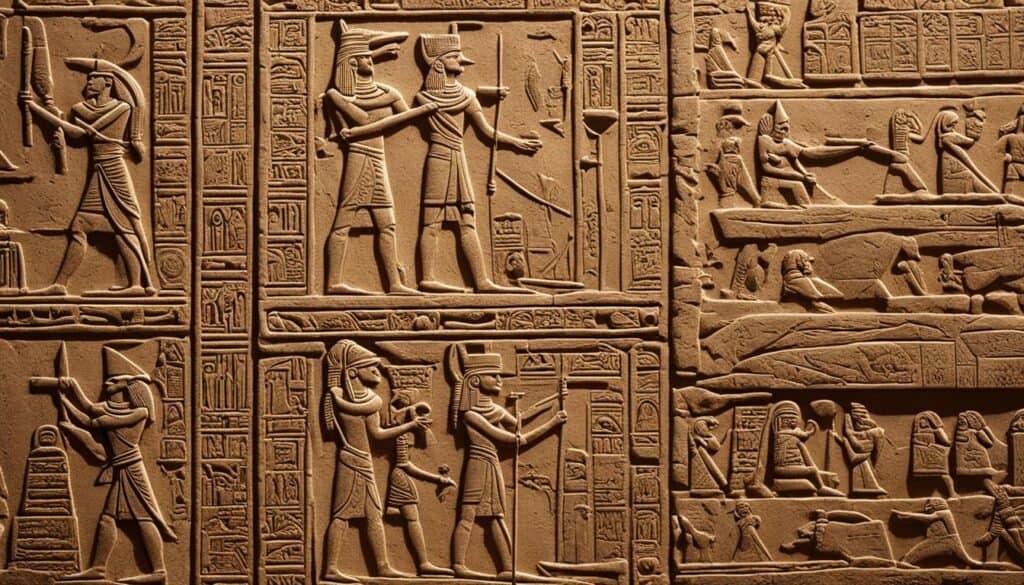
As we keep looking at the links between archeology and the Bible, the Merneptah Stele shows us new things. It leads to more study about the Israelites and what they left behind in history.
Tell Dan Stele and the Davidic Kingdom
Genesis takes us back to the beginnings of human history. The Tell Dan Stele is a great find in archaeology. It proves the Davidic kingdom really existed.
The Tell Dan Stele comes from the 9th century BC. It was found in the city of Dan in Canaan. This big stone slab mentions the “house of David.” This gives us a rare look into the history of a kingdom that’s important in the Bible.
The mention of the “house of David” on the Tell Dan Stele is big for us. It gives solid proof that King David really lived. His story is well-known from the Hebrew Bible.
This finding supports the Bible’s history. It makes the story of Genesis more believable by adding real historical facts. The Davidic kingdom was very important in its time. The Tell Dan Stele makes sure we see that.
Though it doesn’t tell us a lot about King David or his kingdom, it still matters. It shows us there was a big political power back then. The Davidic kingdom’s rule mattered a lot and lasted a long time.
“The Tell Dan Stele stands as an inscribed testament to the house of David, validating the biblical accounts and revealing the lasting impact of a remarkable kingdom.”
Excavations at Dan have found more things. These findings tell us more about the Bible. Together, these texts and objects help us better understand the world of Genesis.
The Davidic Kingdom and Genesis
Genesis tells about the first leaders of the Davidic kingdom. The mention of the “house of David” on the Tell Dan Stele links David’s kingdom to the Genesis story.
David is a key figure in Genesis. His crowning as king, his fight against Goliath, and making Jerusalem the capital are key events. The Tell Dan Stele proves the Davidic kingdom really existed. This gives more historical truth to these stories.
The Tell Dan Stele is one of many finds. These discoveries help us understand more about Genesis. Each find makes the ancient world and biblical events clearer.
Ebla Ivory Plaque and Visual Representation
The Ebla Ivory Plaque is a unique piece of ancient art. It shows a banquet with Laban’s sons, characters from Genesis. This scene helps us understand the story about Jacob and his adventures better.
This plaque dates to the late 3rd millennium BC. It comes from the city of Ebla in what is now Syria. Made from elephant ivory, it shows the high level of art and culture back then.
The plaque’s scene lets us see Laban’s sons clearly. They were important in Jacob’s story. Jacob is a key figure in Genesis, and his time with Laban’s sons was critical in his life’s path.
Seeing this image helps us get closer to the characters and events in Genesis. We can imagine the grand meals and the family situations at that time. It helps us feel the culture from back then.
Significance of the Ebla Ivory Plaque
This plaque is more than art; it’s a window into ancient life. The detailed carvings show the artistry and thinking of ancient people.
“The Ebla Ivory Plaque is like a portal to the Genesis world. It makes the people and stories come alive. And these stories are big parts of our history and beliefs.”
Dr. Sarah Carter, Archaeologist
Studying items like the Ebla Ivory Plaque helps us understand Genesis better. It also shows us about the history and culture of that long-ago time. By looking at these visual pieces, we get closer to the ancient stories and their world.
The Cave of Machpelah and Historical Significance
In Hebron, the Cave of Machpelah is very important in religious stories. It’s a place of respect for Jews, Muslims, and Christians. They all see it as the final resting place of key biblical people like Abraham and his family. This makes the place special to people of different religious beliefs.
Also called the Tomb of the Patriarchs, it’s a collection of caves in the West Bank’s Hebron. The construction combines different styles, showing its importance across religions. Each figure has their own space for people to honor.
The Cave of Machpelah means a lot in both religion and history. It’s been a stop for those on religious journeys for a long time. This has helped strengthen bonds between various beliefs over the years.
In the book of Genesis, Abraham bought the site for Sarah’s burial. Later on, it became the place for his family too. This started its link to important figures from the Bible.
For historians and archaeologists, the cave is like a window into the past. The way it’s been kept across the years shows its lasting value. This is true for people of many different beliefs.
Being at the Cave of Machpelah or seeing people pray there can be moving. It reminds us how faiths are connected and how historical figures can still have a big effect.
How Do Archaeological Discoveries Relating to Genesis Support or Challenge Prevailing Cultural Narratives?
Archaeological discoveries relating to Genesis often reveal cultural practices far older than previously assumed, reshaping interpretations of human history. These findings prompt scholars to question long-held historical assumptions, compelling societies to reconsider how genesis reshaped traditional cultural narratives and influenced religious and cultural development across time. The debate continues in both academic and religious circles.
Ziggurats and the Tower of Babel Story
Ziggurats were ancient stepped pyramid buildings in Mesopotamia. They look like the Tower of Babel from the story. These structures were more than just impressive. They were used for religious ceremonies and to run cities.
The ziggurats were carefully built. They showed off the great skills and knowledge of the people during that time. These buildings were huge, showing everyone the amazing abilities of ancient societies.
The Tower of Babel is often seen as a story about humans trying to be as powerful as gods. But, the ziggurats show us something else. They show us the detailed and organized ways the ancient people managed their societies and worshipped their gods.
Affiliate Disclosure: "As an Amazon Associate I earn from qualifying purchases made from links in this post. We are a participant in the Amazon Services LLC Associates Program, an affiliate advertising program designed to provide a means for us to earn fees by linking to Amazon.com."

